Services on Demand
Article
Indicators
Related links
-
 Cited by Google
Cited by Google -
 Similars in Google
Similars in Google
Share
South African Journal of Industrial Engineering
On-line version ISSN 2224-7890
Print version ISSN 1012-277X
S. Afr. J. Ind. Eng. vol.24 n.2 Pretoria Jan. 2013
CASE STUDIES
Fuzzy Analitic Network Process based Multi Criteria Decision Making methodology for a family automobile purchasing decision
A. Yesim YaylaI; Aytac YildizII, *
IMechanicalEengineering Department, Marmara University, Faculty of Technology, Göztepe, Istanbul, Turkey. yayla@marmara.edu.tr
IIAutomotive Technology Program Amasya University, Vocational School of Technical Sciences, Amasya, Turkey. aytac.yildiz@amasya.edu.tr
ABSTRACT
Nowadays, in parallel with the advancing technology, automobiles that have substantially advanced technological properties are being manufactured. Intended uses of the automobiles have been changing in our days in contrast to 1960s when automobiles were only used for transportation. Consumers, in our day and age, expect profoundly different properties from an automobile. In this context, more than one criterion become effective on making decision on purchasing an automobile that has the required properties. In such a kind of decision problem, making use of Multi Criteria Decision Making (MCDM) methods will ease the solution of the problem and will enable the decision makers to make right decisions. In this study, fuzzy Analytic Network Process (ANP) method, one of the MCDM methods, is used in automobile purchasing decision making. After determining decision criteria and alternatives, network structure of the automobile selection decision problem is formed, and by using fuzzy ANP method, the best one is selected among three alternative automobiles that are in the same segment and are very approximate to each other in terms of their properties and prices.
OPSOMMING
Motorvoertuie word in die huidige tydsgewrig deur vervaardigers met gevorderde tegnologiese eienskappe toegerus. Gevolglik word meer as 'n enkele kriterium deur voertuiggebruikers aangewend om 'n moderne model te evalueer. Sodanige evaluering word in hierdie navorsing gebaseer op 'n wasige analitiese netwerk metode. Nadat alle besluitvormingskriteria en alternatiewe vasgelê is, word die wasige model gebruik by die seleksie van 'n bepaalde voertuig uit 'n monster van drie soortgelyke voertuie.
1. INTRODUCTION
Recently the production life cycle has become shorter. Constant changes in customer demands lead manufacturers to produce new and improved designs. Automation of manufacturing technologies allows this [1]. As the automobile market becomes more competitive, the industry has no choice but to adopt innovation that brings better customer service.
In everyday life, economical, industrial and financial decision problems have multi criteria structures [1, 2]. In the context of shopping, purchasing an automobile is important to include elements that provide attributes that make consumer decision-making easier, comfortable and therefore, lead to a car purchase [2]. Purchasing a car is costly, the consumers in the market tend to behave like rational decision makers. They naturally compare the attributes of cars (e.g., brand preference, fuel economy, safety, comfort) and make overall decisions [3]. Before someone shops for a new car, he or she wants to take a look at finances and options. The possible budget is then a constraint in the decision on which car to buy. Many customers seek advice from car experts or friends when purchasing a car. In many cases, there are times when the price and special features do not match the budget. The frequency of making such a decision is much less, as the average person does not purchase cars annually and the effect is greater than, saying that of buying laundry powder. Most people shopping for a new car rank safety high among their purchase considerations. Other important attributes include: fuel economy; comfort and convenience features; insurance information; specification and warranties and resale value [1]. Purchasing an automobile is a decision making problem and reflects the preferences of the purchaser [2]. In that, the weight of selection criteria is different for each. Every alternative may be superior with different properties. That is why, it is not easy to make the best selection in these kinds of problems [4].
In this study, family automobile purchasing case is handled as a kind of MCDM problem. In the following sub sections a literature review is presented, a concise information about MCDM and fuzzy ANP process is given. Steps of the ANP methodology for the real case study are introduced afterwards. Finally, the results are presented and discussed.
2. LITERATURE REVIEW
While giving some critical decisions like automobile selection, decision makers need reliable assessment process. Determining the best one among available alternatives is one of the subjects that leave the decision makers in a difficult situation. Traditional methods cannot generate a realistic solution in this selection process [5]. However, MCDM methods significantly ease the solution and enable the decision makers to make right decisions [6]. MCDM can be split up into three in terms of data they use; deterministic, stochastic and fuzzy. It is the expression of verbal thought that underlies fuzzy logic and fuzzy set theory which is used for vagueness and is one of the strongest means in decision making problems [5].
When literature is reviewed on this subject, it is seen that Analytic Hierarchy Process (AHP), Analytic Network Process (ANP), ELECTRE, Techniques for Order Preference by Similarity to Ideal Solution (TOPSIS), Fuzzy ANP (FANP), Fuzzy TOPSIS and Data Envelopment Analysis (DEA) take place among the methods that will be used for MCDM [8-12].
Gungor and Isler [13], in their study, used AHP method in the selection of the best one among eight alternative automobiles. In the study, the criteria were determined as price, second hand price, fuel consumption (fuel price, fuel cost), acceleration in 0-100 km, comfort, safety, maintenance cost, width and sympathy level, and at the end of the study, the best automobile selection was made.
Byun [2] used AHP method in order to make a selection among three alternative automobiles and took price, safety, fuel economy, comfort and appearance as the selection criteria. At the end of the study, automobiles were lined up in accordance with the priority weights of the alternatives.
Terz et al. [14], in their study, proposed a decision support model which benefits from AHP and goal programming for the purpose of making decision in automobile purchasing problem. They utilised these methods for making a selection among the models of an automobile brand which has an important part in Turkey market and the results were assessed. In their study, they determined performance (cylinder volume, engine power, handling), economy (price, tax, fuel consumption), after sale advantage (after sale service amount, second hand premium rate, liquidity), image and prestige (comfort, design-aesthetic and safety) as automobile purchasing criteria.
Raut et al. [15], in their study, proposed an integrated model from the most important and usable MCDM techniques, means AHP and Quality Function Deployment (QFD)-fuzzy technique for preference, in order to examine the improvement fields of Indian automobile industry. A new approach, Analytic Quality Function (AQF) method, has been suggested to combine the results of three techniques to find the final ranking. Besides, they propose a developing QFD-fuzzy model as a basis for comparing the reliability of results of the MCDM techniques, which depicts that AQF is more reliable than other MCDM techniques. Their results have certified that technology, economical aspects, style, comforts, safety, tools availability, convenience, social aspects, aesthetics view, and manufacturers are the customers' most important criteria for automobile selection.
Sahin and Akyer [16], in their study, dealt with the use of AHP and TOPSIS methods in the selection of 4x4 search and rescue vehicles. For a 4x4 pickup, selection criteria were determined as fuel consumption, price, width (indoor), 0-100 km acceleration, maximum speed, load capacity, comfort, safety, safety device it has and availability of a service. The criteria determined were weighted separately for four alternative automobiles by using AHP and TOPSIS methods, and a selection was presented by assessing the technical properties of these vehicles in accordance with these weights. In the selection of the best one among four different models of automobiles, AHP and TOPSIS methods gave the same result.
Buyukozkan and Cifci [17] used FANP method for the supplier selection in a firm, active in white goods sector in Turkey. Five alternative supplier firms were assessed in accordance with four supplier selection criteria and as the result, the best one was selected by lining up the alternative suppliers. At the end of the study, sensitivity analysis was also made. Wei et al. [18] used FANP method in the selection of the best supplier among the alternatives for a TV manufacturer.
Vinodh et al. [19], in their study, made for the supplier selection in the Indian electronics industry, used FANP method. In the study, three alternative supplier firms were assessed in accordance with five supplier selection criteria and as the result, the best one was selected by lining up the alternative suppliers. At the end of the study, sensitivity analysis was also made.
Razmi et al. [12] used FANP method for supplier selection. In the study, four alternative suppliers were assessed in accordance with six supplier selection criteria and alternative suppliers were lined up with the method used. At the end of the study, sensitivity analysis was also made.
3. FUZZY ANALYTIC NETWORK PROCESS
Fast and effective decision making has become of the most important targets of companies in this competitive environment. Fast adaptation of companies to the rapidly changing environmental circumstances and fast decision making in parallel with this change are only possible with the use of scientific methods that can assess many qualitative and quantitative factors all together in decision process.
ANP is a follow up of AHP as well as being a new and an omnibus decision making method [20]. In AHP method; purpose, criteria, sub-criteria and the relations among the alternatives are dealt with hierarchically [21]. As to ANP, it enables to present all criteria, sub-criteria and every kind of dependencies and feedbacks among the alternatives that affect the decision making process systematically. The superiority of decision making model formed by using ANP method comes from the easy expression of decision making problems that have complex interactions by not adhering to any hierarchy. The method enables not only pair-wise comparison of sub-criteria under certain main criteria but also independent comparisons of all sub- criteria that have interactions with each other [22].
In ANP method, decision makers may encounter vagueness and multiple meanings on assessing possible alternative set. Because of this vagueness and uncertainty in the opinions of decision makers, pair-wise comparisons made in classical ANP remain incapable in reflecting the real opinions of decision makers. In order to cover up the deficiency of classical ANP, fuzzy logic approach may be based on [23]. Accordingly, the use of fuzzy ANP instead of ANP removes the problem in cases that decision makers remain incapable in reflecting their opinions.
In FANP method, problem is modelled by using network structure; meanwhile, the dependencies among the sub-criteria in all criteria sets and internal dependencies belonging to sub-criteria in each criteria set are taken into consideration. Fuzzy ANP method enables the decision making problems to be solved in a more effective and realistic way due to the fact that it can comprise internal dependencies and mutual interactions among criteria [12].
In the real case study within the scope of this study, the FANP method will be used. The best one was selected among three alternative automobiles that were in the same segment and were very approximate to each other in terms of their properties and prices.
4. FUZZY ANALYTIC NETWORK PROCESS METHOD FOR THE CASE STUDY IN FAMILY AUTOMOBILE PURCHASING DECISION
In the proposed method, FANP has been used for a family automobile purchasing decision. The ANP can be considered as a more general form of the AHP in which dependencies and feedbacks between elements of a decision can be modelled. Although ANP is one of the most complete and comprehensive MCDM methods as it encompass the criteria and alternatives in an integrated manner, it has a great drawback in the pair-wise comparison section. Real world has an indeterminate nature. A large amount of uncertainty is associated with various parameters of the family automobile purchasing models and thus, to cope with this drawback, fuzzy sets theory [24] is adopted in this research. Even though the discrete scale of 1-9 has the advantages of simplicity and easiness for use, it does not consider the uncertainty associated with the mapping of one's perception or judgment to a number. On the other hand, decision maker's perception about the family automobile purchasing can be vague and ambiguous, hence cannot be expressed with indefinite numbers. In this approach, pair-wise comparison matrices are formed among various criteria of each level with the help of triangular fuzzy numbers (TFN). The detailed definitions and discussions on TFN can be found in Onut et al. [25], Kaufmann and Gupta [26] and Wagenknecht et al. [27]. FANP can easily accommodate the interrelations existing among the functional activities. The concept of supermatrices is employed to obtain the composite weights that overcome the existing interrelations. The following sub-sections describe the steps of the methodology for the real case study.
4.1 Determination of criteria and alternatives and network formation
In this step, criteria which affect the decision must be defined. In the problem, each main criteria and sub-criteria were generated under the light of literature [2, 13, 14, 16] as well as decision making group's common opinion. The group were formed with four members.
Three of the group members were family automobile purchasers having knowledge and experiences of car market and the fourth one was the person thinking of purchasing a family automobile. Accordingly, five main criteria were determined as performance, safety, comfort, economy and after sale services. Defined five main criteria and sub-criteria are as in Table 1.


4.2 Pair-wise comparisons and computing steps of fuzzy analytic network process method
After forming the network structure relating to the family automobile selection to be purchased, firstly, the main criteria serving for the purpose were compared. Then, subcriteria determined for each main criteria were compared among themselves and among the alternatives; for each sub-criteria, the relations, of all sub-criteria effecting this subcriteria, with each other were taken into consideration and pair-wise comparison matrices were formed. These matrices were filled by the person thinking of purchasing an automobile with linguistic scales as in Table 2.
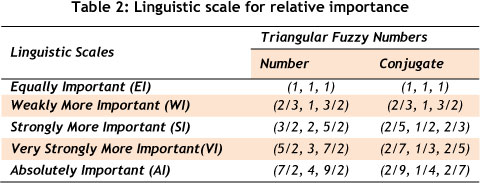
In the computing steps of fuzzy ANP method, fuzzy values were clarified by using Chang's extension method (1996). The steps of Chang's extent analysis approach are as follows: Let X ={x1x2,..., xn} be an object set and U = {u1,u2,.., um} be a goal set. According to the extension method, each object is taken and extent analysis for each goal, gi, is performed, respectively. Therefore, m extent analysis values for each object can be obtained, with the following signs:

Where all the Mjgi (j = 1,2,.··,m) are triangular fuzzy numbers (TFNs) of which parameter is l, m and u. The parameter l, m and u, respectively, present the smallest possible value, the modal value and the largest possible value that describe a fuzzy event [28,29].
The steps of Chang's extent analysis can be given as below. In these steps, as an example of computation, only pair-wise comparisons of main criteria with respect to goal were given place.Where, pair-wise comparisons of main criteria with respect to goal filled by the person thinking of purchasing an automobile with linguistic scales as in Table 2 and then Table 3 was obtained.
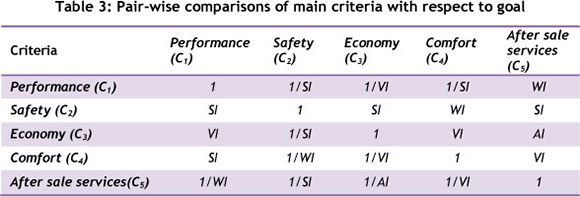
Afterwards, linguistic scales in pairwise comparison matrice was turned into triangular fuzzy numbers as in Table 2 and then Table 4 was obtained.
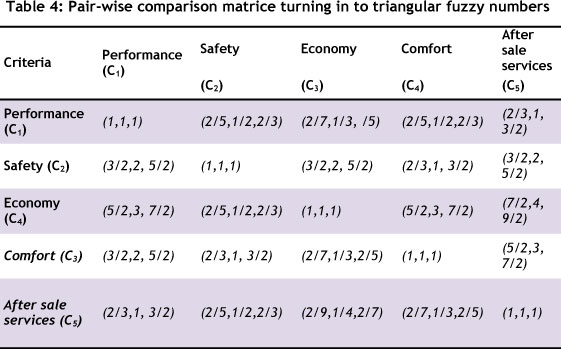
Step 1: The value of fuzzy synthetic extent with respect to the i. object is defined as:

To obtain  the fuzzy addition operation of m values for a particular matrix is performed as
the fuzzy addition operation of m values for a particular matrix is performed as

And to obtain  , the fuzzy operation of Mjg (j = 1,2,...,m) values is performed as
, the fuzzy operation of Mjg (j = 1,2,...,m) values is performed as

And then the inverse of the vector in (5) should be computed.

As an example, for each main criteria the value of fuzzy synthetic extent (Sj) was computed using Eq.(2), Eq. (3), Eq. (4) and Eq. (5) as bellows:

Step 2: The degree of possibility of M2 = (l2, m2, u2 ) > M1 = l1,m1,u1) is defined as

And can be equivalently expressed as follows:
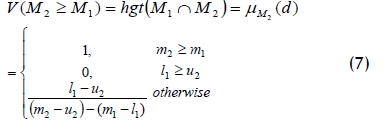
Where d is, as shown in Figure 2, the ordinate of the highest intersection point D between  and
and  .
.

To compare M1 and M2 , we need the values of both V(M1≥M2) and V(M2≥M1)
As an example, for each main criteria V(M2≥M1) value was computed using Eq.(6) and Eq. (7) as bellows;

Step 3: The degree possibility for a convex fuzzy number to be greater than k convex fuzzy Mi (i = 1,2,..., k) numbers can be defined by:

For k = 1,2,...,n;k≠i

Then the weight vector is given by

Step 4: The normalized weight vectors are

Where W is a non-fuzzy number.
For the main criteria, compared pair wisely with respect to goal, the normalized weight vector WMC is obtained using Eq(8), Eq(9), Eq(10) and Eq(11) as below;
WMC = (0.000, 0.277, 0.522,0.201, 0.000)T
The weighted vectors for every comparison matrices were obtained from with the same implementation of algorithm steps on the matrices obtained as a result of comparison of the sub-criteria with respect to the main criteria, the criteria related to each other with respect to each other, and the alternatives with respect to the sub criteria
4.3 Supermatrix calculation
In the process of clarification, Chang's extension method (1996) based Microsoft Excel compatible spreadsheet was created to acquire calculation easiness and speed. By the use of this spreadsheet, priority weights for each pair-wise comparison matrix were obtained. Priority weights obtained from the clarification process were transferred into Super Decisions 1.6 software package, commonly used in ANP method, via "Direct Data Entry" menu; and un-weighted super matrix (Table 5), weighted super matrix (Table 6) and limit matrix (Table 7) were obtained respectively. A priority weight was obtained from this limit matrix for each alternative and the alternative with the highest priority weight was determined as the best.
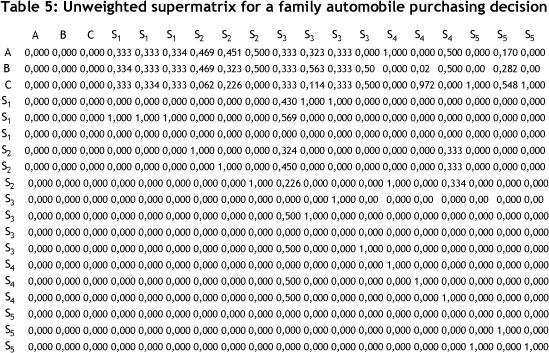
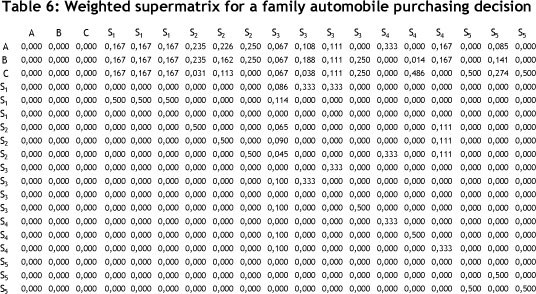
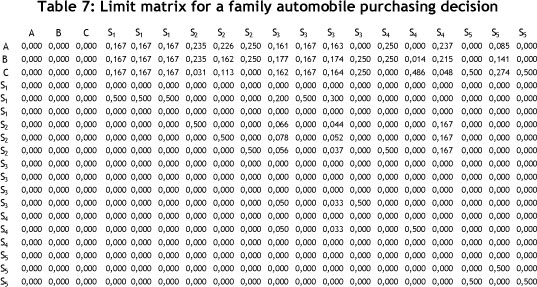
All the data taken into account in the software package are presented in Table 5. From the table it could easily followed which element affects to which element at what level. However, at this stage this data does not yield useful information yet. Thus the weighted matrix is needed. The criteria weights are utilised in weighting the supermatrix blocks. The weighted supermatrix was obtained by multiplying the relative priorities in every supermatrix with the priorities of cluster, Table 6. The last priorities related with the alternatives are obtained with normalisation of every column in Table 7 and the alternative possessing the highest priority weight was selected as the best alternative. In the limit matrix, it can be seen which element affects which element in what extend.
Figure 3 and Figure 4, respectively, show the network structure formed in the software package, the relations among the elements in this network structure, the screens in which weight vectors obtained from the computing (according to Chang's (1996) Fuzzy AHP method) were transferred into the software package and the result screen.

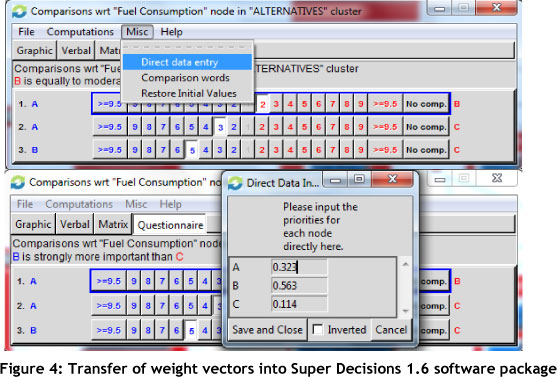
4.4 Selection
Priority values of the criteria can be obtained from the data taken from limit matrix. These priority values make a great contribution in terms of screening the priority levels of the criteria of decision problem relating to the selection of the automobile. Related priorities are in Figure 5.

When we look at the priority values of criteria in Figure 5., the result screen of the software package, three of the decision making criteria, for the model we have made, are respectively engine power (with the highest priority value =0.211 ), roadholding (with the priority value = 0.090) and safety systems (with the priority value = 0.077).
Priority values relating to the alternatives of which the criteria weights were computed are in Figure 6. As seen in the figure, automobile "B" has the highest priority value with 36.08%.
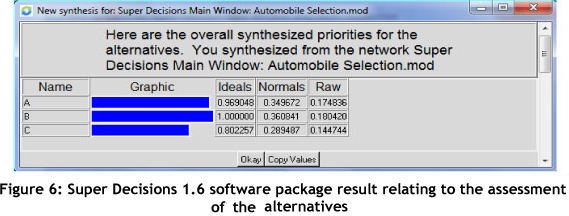
5.RESULTS AND DISCUSSION
In the most general terms, decision making problem is the determination of the best one among alternatives in accordance with at least one purpose or criteria meeting the needs of the customer expectations. The multi criteria decision making is the selection process that the decision maker makes by using at least two criteria from a set of countable finite numbers or uncountable number of alternatives.
In this study, the solution of automobile purchasing problem is dealt with the use of fuzzy ANP method, one of the MCDM methods. The use of this method enables all the elements of network structure relating to the automobile selection to affect the result. It enables weights of not only the alternatives but also the sets they are in to make effect on their weights. Thanks to the feedbacks, the possibility of the data's reflecting the truth is increased and taking the vagueness situation into account is enabled. It is seen that, considering the opportunities it gives, fuzzy ANP method is also used in the studies of [17, 18, 19].
Decision model formed within the study consists of sixteen criteria and three alternative automobiles in the same segment. Network structure are formed after the relations among the criteria are determined and pair-wise comparison matrices are obtained by abiding by this network structure. Acquired pair-wise comparison matrices are assessed by the consumer who thinks of purchasing an automobile, and priority weights are obtained belonging to pair-wise comparison matrices by computing according to fuzzy AHP method. When the results that are obtained by transferring this weights into Super Decision 1.6 packaged program are analyzed, it is seen that the most important criterion in family automobile selection is engine power with the highest priority level, which is in line with the similar studies [2, 13] in the literature and automobile "B" is seen as the best solution to family automobile purchasing decision problem with 36.08 % priority level, which meets the needs of customer expectations in the most appropriate way under the light of the decision criteria taken into account. As to other alternatives, automobile "A" has 34.97 % and automobile "C" has 28.95 % priority values.
Based on these results, according to the criteria specified in the study of consumers looking for to buy a car, the car B would be more appropriate. Fuzzy ANP method together with the network structure relating to the automobile selection to be purchased proposed in this study for purchasing the best automobile would help the consumers when purchasing a car based on a multi-criteria decision making methods. Furthermore this method is a better solution to the qualitative evaluation of the problems which is difficult to quantify.
This study has importance in terms of the decision model, network structure and obtained solution results to not only the consumer but also the automobile manufacturer's design decision. For the future studies, the scope may need widened to include the same arguments for the industrial and corporate consumer.
REFERENCES
[1] Korhonen, P., Moskowitz, H. & Wallenius, J. 1992. Multiple criteria decision support-review. European Journal of Operational Research, 63, 1992, pp 361-375. [ Links ]
[2] Byun, D. 2001. The AHP approach for selecting an automobile purchase model. Information and Management, 38, pp 289 - 29. [ Links ]
[3] Kim, S., Lee, K., Cho, J.K. & Kim, C.O. 2011. Agent-based diffusion model for an automobile market with fuzzy TOPSIS-based product adoption process. Expert Systems with Applications, 38, pp 7270-7276. [ Links ]
[4] Brans, J.P. & Mareschal, B. 1998. How to decide with promethee. Visual Decision Inc. Montreal, Canada. [ Links ]
[5] Wanga, J.W., Cheng, C.H. & Kun-Cheng, H. 2009. Fuzzy hierarchical TOPSIS for supplier selection. Applied Soft Computing, 9, pp 377-386. [ Links ]
[6] Ha, S.H. & Krishnan, R. 2008. A hybrid approach to supplier selection for the maintenance of a competitive supply chain. Expert Systems with Applications, 34(2), pp 1303 -1311. [ Links ]
[7] Shahanaghi, K. & Yazdian, S.A. 2009. Vendor selection using a new fuzzy group TOPSIS approach. Journal of Uncertain Systems, 3(3), pp 221-231. [ Links ]
[8] Shyur, H.J., & Shih, H.S. 2006. A hybrid MCDM model for strategic vendor selection. Mathematical and Computer Modelling 44, pp 749-761. [ Links ]
[9] Ho, W., Xu, X. & Dey, P.K. 2010. Multi-criteria decision making approaches for supplier evaluation and selection: A literature review. European Journal of Operational Research, 202, pp 16-24. [ Links ]
[10] Liao, S.K., Chang, K.L. & Tseng, T.W. 2010. Optimal selection of program suppliers for tv companies using an analytic network process (ANP) approach. Asia-Pacific Journal of Operational Research, 27(6), pp 753-767. [ Links ]
[11] Chan, F.T.S. 2003. Interactive selection model for supplier selection process: an analytical hierarchy process approach. International Journal of Production Research, 41(15), pp 35493579. [ Links ]
[12] Razmi, J., Rafiei, H. & Hashemi, M. 2009. Designing a decision support system to evaluate and select suppliers using fuzzy analytic network process. Computers & Industrial Engineering, 57, pp 1282-1290. [ Links ]
[13] Gungor, I. & Isler, D.B. 2005. Analitik hiyerarsi yaklasimi ile otomobil seçimi. ZKÜ Sosyal Bilimler Dergisi, 1(2), pp 21-33. [ Links ]
[14] Terz, U., Hacaloglu, S.E. & Aladag, Z. 2006. Otomobil satin alma problemi icin bir karar destek modeli. Istanbul Ticaret Üniversitesi Fen Bilimleri Dergisi, 5(10), pp 43 - 49. [ Links ]
[15] Raut, R.D., Bhasin, H.V. & Kamble, S.S. 2011. Multi-criteria decision-making for automobile purchase using an integrated analytical quality fuzzy (AQF) technique. International Journal of Services and Operations Management, 10(2), pp 136-167. [ Links ]
[16] Sahin, Y. & Akyer, H. 2011. Ülke kaynaklarinin verimli kullanimi: 4x4 arama ve kurtarma araci seciminde AHS ve TOPSIS yöntemlerinin uygulamasi. Süleyman Demirel Üniversitesi Vizyoner Dergisi, 3(5), pp 72 - 87. [ Links ]
[17] Buyukozkan, G., & Cifci, G. 2011. A novel fuzzy multi-criteria decision framework for sustainable supplier selection with incomplete information. Computers in Industry, 62, pp 164174. [ Links ]
[18] Wei, J.Y., Sun, A.F. & Wang, C.H. 2010. The application of fuzzy-ANP in the Selection of Supplier in Supply Chain Management. International Logistics Systems and Intelligent Management Conference, 9-10 Jan., pp 1357 - 1360. [ Links ]
[19] Vinodh, S., Ramiya, R.A. & Gautham, S.G. 2011. Application of fuzzy analytic network process for supplier selection in a manufacturing organisation. Expert Systems with Applications, 38, pp 272-280. [ Links ]
[20] Bayazit, O. 2002. A new methodology in multiple criteria decision-making systems: Analytical network process (ANP) and an application. Ankara Üniversitesi Siyasal Bilimler Fakültesi Dergisi, 57(1), pp 15-34. [ Links ]
[21] Heart, A.T., Noorossana, R., Parsa, S. & Serkani, E.S. 2012. Using DEMATEL-Analytic network process (ANP) hybrid algorithm approach for selecting improvement projects of Iranian excellence model in healthcare sector. African Journal of Business Management, 6(2), pp 627645. [ Links ]
[22] Saaty, T.L. & Ozdemir, M.S. 2005. The encyclicon: A dictionary of decisions with dependence and feedback based on the analytic network process USA:RWS Publications. [ Links ]
[23] Ayag, Z. & Ozdemir, R.G. 2006. An intelligent approach to ERP software selection through fuzzy ANP. International Journal of Production Research, 45 (10), pp 2169 - 2194. [ Links ]
[24] Zadeh, L.A. 1965. Fuzzy sets. Information and Control, 8, pp 338-353. [ Links ]
[25] Onut, S., Tuzkaya, U.R. & Torun, E. 2011. Selecting container port via a fuzzy ANP-based approach: A case study in the Marmara Region, Turkey. Transport Policy, 18, pp 182-193. [ Links ]
[26] Kaufmann, A. & Gupta, M.M. 1988. Fuzzy mathematical models in engineering and management science. North-Holland, Amsterdam. [ Links ]
[27] Wagenknecht, M., Hampel, R. & Schneider, V. 2001. Computational aspects off fuzzy arithmetics based on Archimedean t-norms. Fuzzy Sets and Systems, 123, pp 49-62. [ Links ]
[28] Kahraman, C., Cebeci, U. & Ruan, D. 2004. Multi-attribute comparison of catering service companies using fuzzy AHP: The case of Turkey. Internal Journal of Production Economics, 87(2), pp 171 - 184. [ Links ]
[29] Tuzkaya, G., Ozgen, A., Ozgen, D. & Tuzkaya, U.R. 2009. Environmental performance evaluation of suppliers: A hybrid fuzzy multi criteria decision approach. International Journal of Enviornmental Science and Technology, 6(3), pp 477-490.
* Corresponding author














